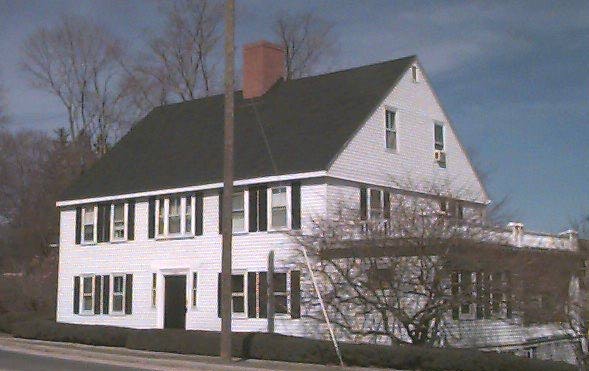Norfolk
"For the fugitive traveling
through northwestern Connecticut, Norfolk was the last stop in
the state. From here, he was sent across the
Massachusetts border to New Marlboro, thence over to the
Housatonic River line through Stockbridge and Pittsfield to
Bennington, Vermont."
(Strother 1962: 126-127
"It is also reported that there was a network of Underground
byways in this vicinity and that residents of Norfolk were
responsible for
paving many of them. (Strother 1962: 126)

G. Pettibone Tavern
Photo by Carol A. Hanny
"...I think we stopped at a tavern kept by Mr. G. Pettibone,
and in him we found a friend."
James Mars (Mars 1864: 40)
"At the northeast corner, (of the Green), is the earlier Giles
Pettibone, Jr. Tavern of 1794, with a curious chimney in
front of the ridge. On the east side is a versatile
building erected for an academy...'
(CT Am. Guide Series 1938: 424)
It was later called the Shepard Hotel. (Thomas
interview)
GPS N 41-59-40 / W 73-11-92
Deacon Amos Pettibone
Colebrook Road, Rt. 282 (Am. Bicentennial Commission of
CT, 1776-1976)
May be the Coon Club
Also known as Shepard Hotel
GPS N 41-59-37 W 73-9-98
"What was called the "Underground Railroad" ran through
Norfolk for many years, and among several 'stations' in the
town, the house
of Dea. Amos Pettibone was one. One of the natives
says: "Dea. Pettibone used to take the passengers on to
the next 'station' in New Marlboro.
I remember his stopping one morning at my home to have us
children see a young runaway slave whom he had kept over
night, and was then
on his way to the next 'station'. He showed the scars on
his ankles where he had worn irons." (Crissey
1900: 299)
Then on to New Marlboro, Stockbridge
This site is listed in Appendix 2, Underground Railroad Agents
in Connecticut. (Strother 1962: 210)
"One of the natives said."I remember his stopping one morning
at my home to have us children see a young runaway slave he
had
kept overnight and was then on his way to the next
station. He showed us the scars on the slave's ankles
where he has worn irons."
(The Underground Railroad in Connecticut, 1976
pamphlet by the American Revolution Bicentennial Commission
of Connecticut)
Lawrence Tavern
-Thomas interview
Corner House? West side of town, Greenwoods Road
West?
Baptist Church
-on Rt. 272 north between
Spauling Road and Campbells Falls Road. On the east
side of the road, the steps are still there.
-Supposedly,
it was burned for helping slaves.
James Mars
-"18th century slave, became
free in a gradula emacipation law in Connecticut enacted
in 1784..." (http:www.courant.com)
-The
Norfolk Historical Library has a booklet on him. The
booklet mentions Underground Railroad sites.
Curtiss Farm
-Thomas interview
Curtiss Corner, junction of Doolittle Drive
Other
mentioned sites
Coon Club
House not far from the corner of route 183 and route 44.
Furnace
-Junction of Haystack Brook and
Blackberry River.
Bloomery
-Samual Forbes and his brother,
Elisha, at the juntion of Hay.stack Brook and the
Blackberry River.